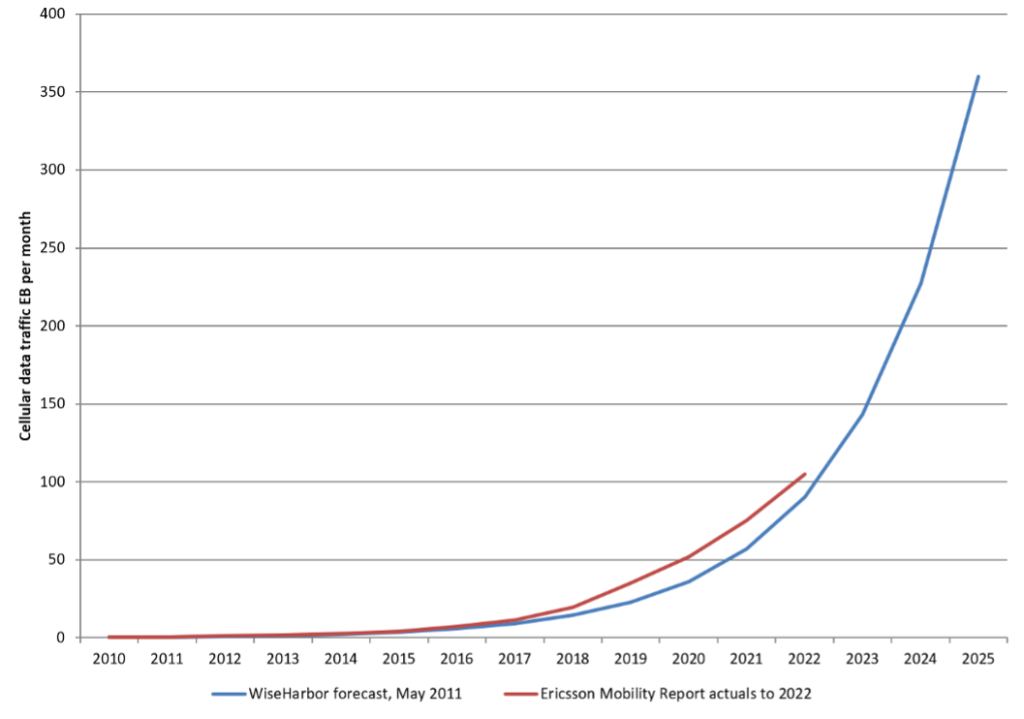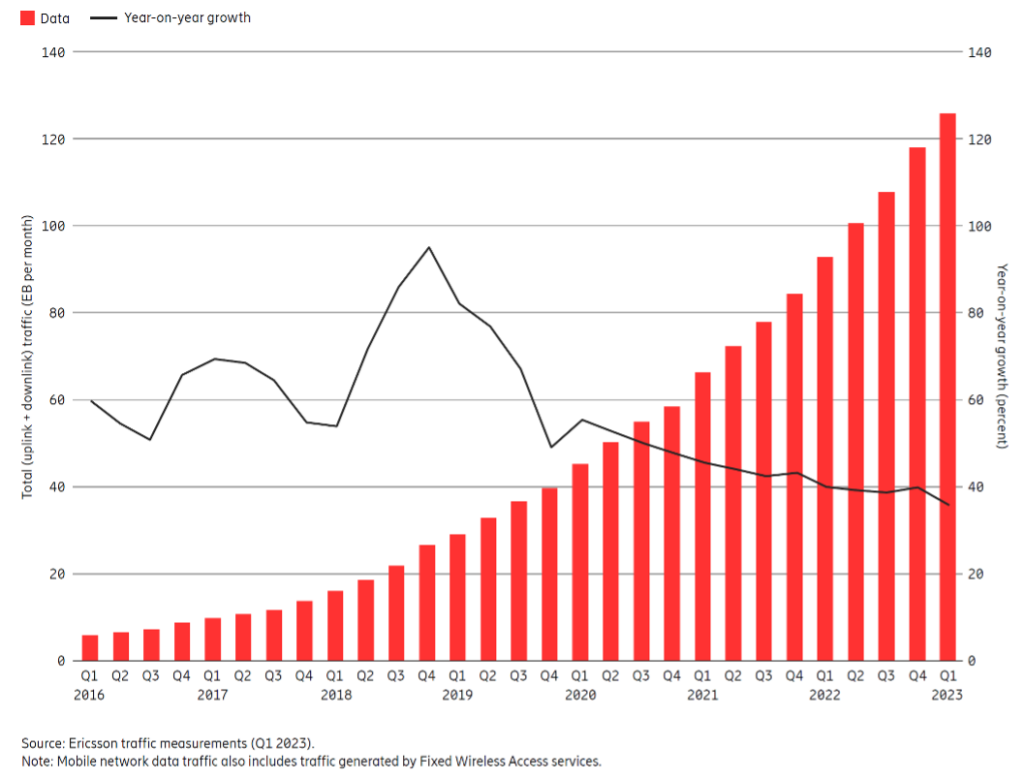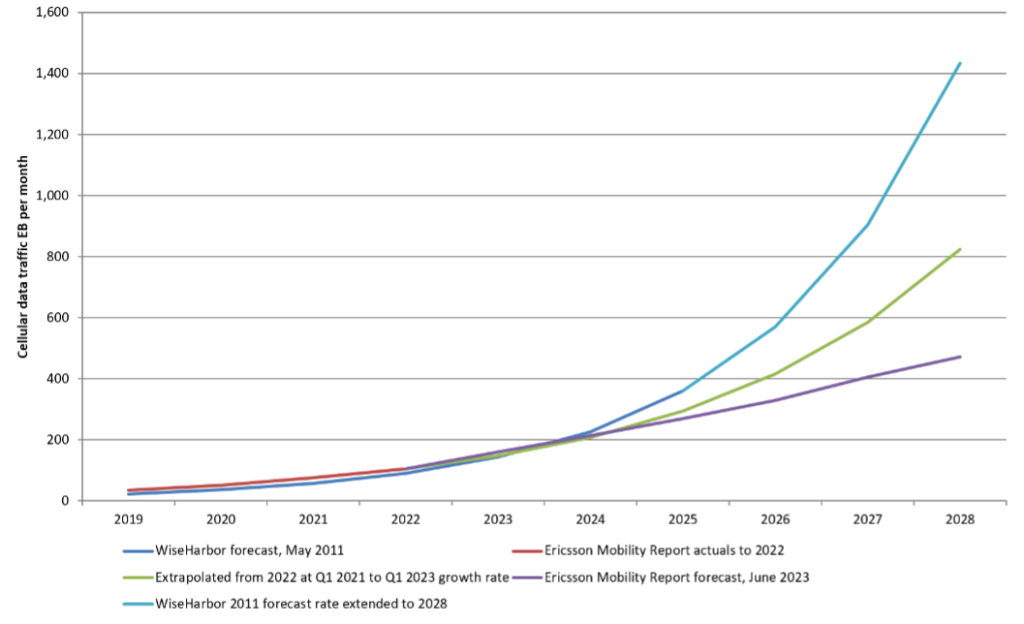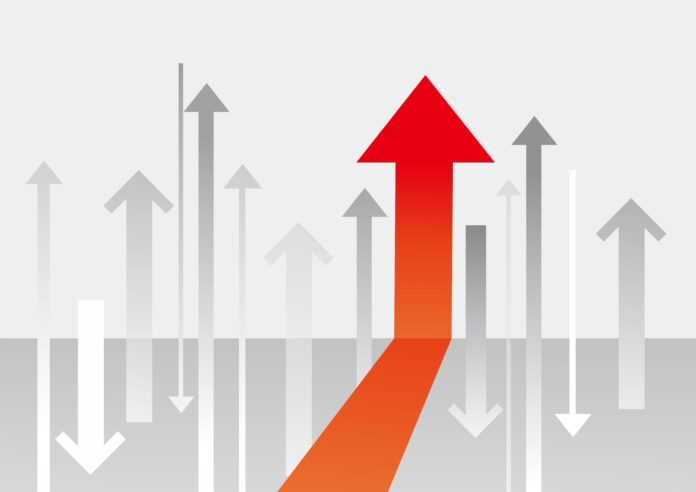The prediction I made in May 2011 — for 1,000-fold cellular data traffic growth over 15 years to 2025 — will most probably turn out correct. I was not the first to anticipate 1,000x growth, but was the only one to publicly state how long that would take in a published forecast. High exponential growth rates now seem likely to persist until at least 2028.
Making up forecasts is stock-in-trade for industry analysts; but they rarely extend more than five or six years. Forecasting can be perilous for various forecasters. Even much shorter-term forecasts for uptake of specific products, services or particular technologies can turn out to be massively mistimed or totally wrong.
Is my accuracy a fluke? How have I managed to get my 1,000x prediction and its timing right over such a long period? My forecast is accurate because my judgment back in 2011 was based on my holistic view over networks, devices and applications, and with me recognizing emerging exponential growth for data versus linear growth in voice calling. I also reflected some significant technical, mathematical and economic factors. My accuracy is not through ability to pick specific new winning services, technologies or to correctly set many individual growth-modeling assumptions. As it turns out, some factors I might have underestimated — such as increasing spectrum supply and usability (i.e. at mid-band and mmWave frequencies) — were offset by others I would probably have overestimated — such as the extent of cell site densification which is a more costly way to increase capacity.
Factors in forecasting
Forecasters are in some cases induced by their paymasters to hype the next new thing with inflated forecasts. Overestimation is potentially embarrassing in technology trend forecasting, but by the time such inaccuracies are apparent most folk have moved on with erroneous forecasts forgotten. While downbeat assessments for new technologies and services can be preferred by certain parties, they can draw immediate criticism from others.
Whereas cellular industry forecasters were repeatedly criticized for underestimating the growth of cellular in the 1990s, for example, plenty of them overshot by orders of magnitude on forecasts for digital cordless telephony with DECT and CT-2 in that period.
On the other hand, getting it right can soon be forgotten. For example, I produced a very upbeat multi-year, multi-nation forecast for ADSL in a bespoke project for Alcatel in the late 1990s. The company capitalized on that as a market leader for many years, but nobody ever came back to me with recognition or accolades for that correct call.
It is also possible to correctly predict outcomes but get the timing very wrong. For example, my research team at a former employer predicted major mid-2000s growth for 3G “location-based services.” That was a decade too soon. Nothing much happened until Uber — the poster child for those services — launched after LTE was up and running in the early 2010s. Prior to my time at that firm, it had predicted, in the early-1980s, that email would prevail over fax machines. For you youngsters out there, the firm was regarded in the early 1990s as getting that wrong because fax — along with telex — ruled the roost for public electronic messaging from the mid-1980s until at least the mid-1990s. The iconic movie “You’ve Got Mail,” depicting email as a novelty, was not released until 1998.
Central banks have also erred, recently, even in their short-term forecasting, by failing to foresee the rapid increases in inflation from month-to-month over the last year. For example, the Bank of England has recently announced its plan to review its forecasting processes to avoid forecasting errors in future.
A bittersweet experience
Some forecasts are not welcome, even though they ultimately come true. In the first half of 2000, I produced a forecast for bulk wholesale transatlantic fiber optic circuits increasing more than one hundred-fold in data capacity from 1999 to 2009. Most other analysts forecasting fiber-optic circuit markets at the time also predicted similar levels of growth. This was straightforward, given that several years of major capacity construction increases had already been announced by operators. However, I also uniquely forecasted that average prices per 155 Mbps circuit would fall by 99.5% over that period. My unpopular verdict for operators was delivered before the tech sector collapse that only started to become apparent at the end of 2000.
According to a paper presented by TeleGeography and the David Ross Group at the May 2010 SubOptic conference in Yokohama, the price for such a circuit fell by 98 per cent from 1999 to 2003 when the last new cable system was introduced. It went on to state that “[e]ven though price erosion has persisted since 2003, the good news for operators, is the pace of erosion has slowed, with the decrease in prices often reflecting reductions in upgrade [to higher capacity on the same fibre] costs.” On the basis of the more prevalent 10 Gbps circuit benchmark used later, the authors calculated a further 60% price decline between 2003 and 2009. All told, that is a price reduction of 99.2 per cent—astoundingly close to my forecast above and well within the margin of uncertainty on market tracking measurements. It was very gratifying to have my accuracy independently verified by other experts after all that time, as my plummeting price projections had made me persona non grata in certain quarters when I made my prediction.
Exponential growth and decay in forecasting
Having the last laugh with the above forecast inspired me to forecast long-term demand for cellular data with the massive growth commencing in the late 2000s; with CDMA2000 EV-DO and HSDPA, and with the commercial introductions of LTE from around 2010. Data has surpassed voice traffic in cellular since the end of 2009.
I perceived similar economics to that observed in silicon chips with Moore’s Law anticipating the cost per transistor halving every two years, and in fiber-optics where the cost of capacity, measured in bits per second, had halved as quickly as every 18 months in the late 1990s. While Moore’s Law held for more than 50 years, I am not aware of Gordon Moore predicting at the outset that such dramatic cost reductions would continue for anything like so long.
By around 2010, I reckoned that the cost per bit per second of cellular data capacity would fall faster than in silicon chips, and—for at least a decade or so — decline at as fast a rate as I had observed in fiber optics around the millennium. I figured that improvements in cellular technology performance would be partly enabled by silicon chip technology and its manufacturing economics, and also in the innovative antenna arrays and software algorithms that enable radio spectrum to be used more efficiently and effectively.
Exponential growth rates in capacity demand are possible where there is exponential decay in costs. I surmised that as cost savings are passed on to consumers — with vigorous competition in technology supply and among cellular operators — a compound annual data growth rate (CAGR) of 58% (i.e. doubling every 18 months) would result in 1,000x being reached in 15 years from 2010.
In May 2011, I stated: “While data traffic grows more than 1,000-fold, operator revenue yield per megabyte will decline dramatically from $100 with SMS, $1 in voice and $0.10 with mobile data in 2010 to $0.001 [i.e. $1 per GB] with data predominating in 2025 (global averages including post-paid and prepaid plans).” The latter figure, which is simply total cellular operator service revenues divided by total data traffic globally, was reached in 2022 and will likely be as low as $0.30 per GB in 2025.
In making my forecast, I gauged that the combination of additional spectrum, improving spectral efficiency and densification in the RAN would enable exponentially increasing network capacity for many years at a similarly reducing cost per bit hauled in the downlinks and uplinks.
I was not so granular in my forecasting as to estimate what proportions of each of those factors would prevail to yield the 1,000x increase. However, I did analyze such figures, as presented to a 3GPP workshop session by SK Telecom a year later in 2012, in an article for the trade press and in a longer paper for 3GPP that it published on its web site for many years. As it turns out, SK Telecom’s expert underestimated how much new spectrum would become available (i.e. only 3x) while overestimating the extent of densification any time soon (i.e.56x). The latter is a rather costlier approach, despite the eye-wateringly large sums raised in some spectrum auction, including $81 billion raised in the U.S. for C-Band at 3.7 GHz in 2021.
Improving technology is also playing its crucial part in several ways: it is increasing spectral efficiency (e.g. with use of higher order modulation such as up to 1024QAM); it is increasing spectrum reuse within cell sites with various flavors of MIMO; and, with 5G in particular, it is enabling much more effective access to higher frequency bands including mmWave where bandwidths are exponentially larger.
The SK Telecom presentation (made long before standardization of 5G and mmWave) estimated a 6x increase in spectral efficiency and calculated the “Required Performance” increase of approximately 1,000x by multiplying its three estimated increases together (i.e. 3 x 56 x 6 = 1,008).
Whether the capacity increase, for example, from massive MIMO is in the spectrum efficiency category, or in the densification category with spectrum being reused spatially, is in the semantics. However, either way, the overall effect on increasing network capacity is the same.
In building my forecast, I did not predict which new apps would drive such growth or when they would take off.
Outstanding growth to 2025 and beyond
Checking my forecasted figures against actual cellular data traffic figures in 2016 and in 2018 showed that my exponential growth modelling was approximately correct. Ericsson’s Mobility Reports (formerly called Traffic and Market Data Report) since 2011 are a very useful information source including the global data traffic figures I used for the base year of 2010 in my forecast and that I have used to track the accuracy of my 1,000x forecast over the last 12 years.
In what is now the last three years of my 15-year forecast, actuals over the last few years are somewhat ahead of my forecast and it seems highly likely that my prediction of 1,000x traffic growth over that period to 2025 will be spot on — give or take six months. Exhibit 1 compares my forecast with actuals from the Mobility Reports over the entire period. Global cellular data traffic volumes including mobile and Fixed Wireless Access (FWA) are now measured in exabytes (EB) per month. (1 EB =1018 bytes). My forecast and the Mobility Reports used to measure in petabytes (PB). (1 EB = 1,000 PB).
Exhibit 1: Global cellular network data traffic — actual figures to 2022, forecast to 2025

Exhibit 2 reproduces a chart from the latest Mobility Report, published June 2023, showing total data traffic and growth rates with the latter declining over the last couple of years.
Exhibit 2: Global mobile network data traffic and year-on-year growth

I believe it more likely growth rates will increase back towards my forecasted CAGR of 58% and of the long-term growth trend in actual figures around that percentage, and at least remain at the last two years’ levels of around 40%, than to reduce much further as this new Mobility Report forecasts. Three growth rate scenarios to 2028 are presented in Exhibit 3.
Exhibit 3: Global cellular network data traffic — actual figures to 2022, forecasts to 2028

I believe the latest Mobility Report’s growth forecast for “total mobile network traffic,” presumably including FWA, of only 26% CAGR from 2022 to 2028 is much too low. Similarly, while the June 2017 Mobility Report forecasted 42% CAGR from 2016 to 2022, the actual percentage turned out to be around 12% higher. Compounding 12% over the six year period is a doubling. With Ericsson anticipating flat RAN sales revenues over the next few years — significantly due to pricing at lower margins with the shift to 5G — maybe it prefers to be conservative rather than accurate about rising network capacity demand in its public forecasting. A bigger pie is additional incentive to new-entrant Open RAN vendors and their financial backers seeking to take a slice of 5G by providing low-cost equipment supply. Public forecasting might be best left to those with less skin in the game. Trustworthy forecasters need to be diligent and independent of vested interests in any particular predicted outcome.
Broadcasting is in dire straits: I want my terabyte TV
Here are some reasons why I believe established usage patterns and increasing low-cost supply will ensure high data-growth levels persist until at least 2028.
Video accounts for 71% of cellular data traffic. The latest Mobility Report also plausibly forecasts this will increase to 80% by 2028. Data traffic volumes in video will continue to increase massively on mobile devices and over FWA.
FWA will have a most significant impact on data growth over the next five years as FWA connections account for an increasing proportion of total connections and with increasing data traffic per connection. While the latest Mobility Report’s forecasted increase in FWA subscribers from 107 million in 2022 to 300 million in 2028 might well be realistic, its implied data growth from 224 GB per month to 477 GB per month per subscriber over the 6-year period is very timid. For example, T-Mobile USA boasts an average of 478 GB per month already in 2022.
Watching TV is a use case well-established over many decades worldwide. However, there is a sea change occurring globally in TV watching—away from “linear” TV via terrestrial, cable or satellite connections to streaming via Internet connections. In addition to increased streaming on smartphones and other small devices, many households are also switching entirely to “digital” delivery (i.e. streaming) of all TV programming including linear format live sports and breaking news on their huge-screen UHD TV sets and other devices. Some major “broadcasters,” including the BBC with its successful iPlayer Internet portal, are promoting this change. It has announced it is preparing to go online-only over the next decade. Even those that are not “cutting the cord” are streaming ever-increasing proportions of their TV watching over fibered, wired (i.e. cable or DSL) or FWA connections.
India is set to drive significant growth in total global cellular data traffic. The latest Mobility Report’s forecast for total mobile traffic including FWA in India of only 22% CAGR from 2022 to 2028 is also extremely conservative. Since April 2023 the nation has overtaken China to become the world’s most populace. India is only just getting started in 5G with its first spectrum auction for that in August 2022 including frequencies in the 700 MHz, 800 MHz, 900 MHz, 1800 MHz, 2100 MHz, 3300 MHz and 26 GHz frequency bands. More spectrum will be released next year. Indians evidently have a massive appetite for video content from Bollywood and elsewhere, so long as it can be accessed cheaply enough, regardless of which device and screen they watch it on.
And, there is also the possibility for other killer apps or devices to pop up and add significantly to the data traffic totals. Do not expect me to predict in my overall data forecasting when or whether that will be from XR headsets, C-V2X, cloud gaming, private enterprise network 5G provisioned from public network slicing, or anything else specifically. However, I can assure you that some major new growth drivers will also emerge over the next five years.

